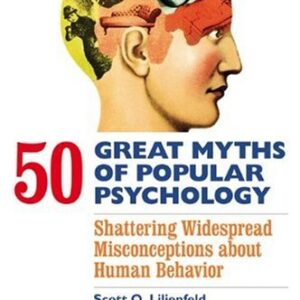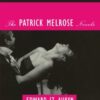Product Description
50 Great Myths of Popular Psychology uses popular myths as a vehicle for helping students and laypersons to distinguish science from pseudoscience.
- Uses common myths as a vehicle for exploring how to distinguish factual from fictional claims in popular psychology
- Explores topics that readers will relate to, but often misunderstand, such as 'opposites attract', 'people use only 10% of their brains', and 'handwriting reveals your personality'
- Provides a 'mythbusting kit' for evaluating folk psychology claims in everyday life
- Teaches essential critical thinking skills through detailed discussions of each myth
- Includes over 200 additional psychological myths for readers to explore
Contains an Appendix of useful Web Sites for examining psychological myths - Features a postscript of remarkable psychological findings that sound like myths but that are true
- Engaging and accessible writing style that appeals to students and lay readers alike
Amazon.com Review
50 Great Myths of Popular Psychology uses popular myths as a vehicle for helping students and laypersons to distinguish science from pseudoscience.
- Uses common myths as a vehicle for exploring how to distinguish factual from fictional claims in popular psychology
- Explores topics that readers will relate to, but often misunderstand, such as “opposites attract,” “people use only 10% of their brains,” and handwriting reveals your personality
- Provides a “mythbusting kit” for evaluating folk psychology claims in everyday life
- Teaches essential critical thinking skills through detailed discussions of each myth
- Includes over 200 additional psychological myths for readers to explore
Contains an Appendix of useful Web Sites for examining psychological myths - Features a postscript of remarkable psychological findings that sound like myths but that are true
- Engaging and accessible writing style that appeals to students and lay readers alike
Amazon-exclusive content from Scott O. Lilienfeld, Steven Jay Lynn, John Ruscio, and Barry L. Beyerstein, the authors of 50 Great Myths of Popular Psychology Virtually every day, the news media, television shows, films, and Internet bombard us with claims regarding a host of psychological topics: psychics, out of body experiences, recovered memories, and lie detection, to name merely a few. Even a casual stroll through our neighborhood bookstore reveals dozens of self-help, relationship, recovery, and addiction books that serve up generous portions of advice for steering our paths along life’s rocky road. Yet many popular psychology sources are rife with misconceptions. Indeed, in today’s fast-paced world of information overload, misinformation about psychology is at least as widespread as accurate information. Self-help gurus, television talk show hosts, and self-proclaimed mental health experts routinely dispense psychological advice that’s a bewildering mix of truths, half-truths, and outright falsehoods. Without a dependable tour guide for sorting out psychological myth from reality, we’re at risk for becoming lost in a jungle of “psychomythology.” In our new book, 50 Great Myths of Popular Psychology: Shattering Widespread Misconceptions About Human Nature, we examine in depth 50 widespread myths in popular psychology (along with approximately 250 other myths and “mini-myths”), present research evidence demonstrating that these beliefs are fictional, explore their ramifications in popular culture and everyday life, and trace their psychological and sociological origins. Here, in David Letterman-like style, we present - in no particular order – our own candidates for five big myths of popular psychology. Myth # 1: Most people use only 10% of their brain power
There are several reasons to doubt that 90% of our brains lie silent. At a mere 2-3% of our body weight, our brain consumes over 20% of the oxygen we breathe. It’s implausible that evolution would have permitted the squandering of resources on a scale necessary to build and maintain such a massively underutilized organ. Moreover, losing far less than 90% of the brain to accident or disease almost always has catastrophic consequences (Kolb & Whishaw, 2003). How did the 10% myth get started? One clue leads back about a century to psychologist William James, who once wrote that he doubted that average persons achieve more than about 10% of their intellectual potential. Although James talked in terms of underdeveloped potential, a slew of positive thinking gurus transformed “10% of our capacity” into “10% of our brain” (Beyerstein, 1999). Myth # 2: It’s better to express anger than to hold it in
If you’re like most people, you believe that releasing anger is healthier than bottling it up. In one survey, 66% of undergraduates agreed that expressing pent-up anger--sometimes called “catharsis”--is an effective means of reducing one’s risk for aggression (Brown, 1983). Yet more than 40 years of research reveals that expressing anger directly toward another person or indirectly (such as toward an object) actually turns up the heat on aggression (Bushman, Baumeister, & Stack, 1999; Tavris, 1988). Research suggests that expressing anger is helpful only when it’s accompanied by constructive problem-solving designed to address the source of the anger (Littrell, 1998). Why is this myth so popular? In all likelihood, people often mistakenly attribute the fact that they feel better after they express anger to catharsis, rather than to the fact that anger usually subsides on its own after awhile (Lohr, Olatunji, Baumeister, & Bushman, 2007). Myth # 3: Low Self-Esteem is a Major Cause of Psychological Problems
Many popular psychologists have long maintained that low self-esteem is a prime culprit in generating unhealthy behaviors, including violence, depression, anxiety, and alcoholism. The self-esteem movement has found its way into mainstream educational practices. Some athletic leagues award trophies to all schoolchildren to avoid making losing competitors feel inferior (Sommers & Satel, 2005). Moreover, the Internet is chock full of educational products intended to boost children’s self-esteem. But there’s a fly in the ointment: Research shows that low self esteem isn’t strongly associated with poor mental health. In a painstakingly - and probably painful! - review, Roy Baumeister and his colleagues (2003) canvassed over 15,000 studies linking self-esteem to just about every conceivable psychological variable. They found that self-esteem is minimally related to interpersonal success, and not consistently related to alcohol or drug abuse. Perhaps most surprising of all, they found that “low self-esteem is neither necessary nor sufficient for depression” (Baumeister et al., 2003, p. 6). Myth # 4: Human memory works like a tape recorder or video camera, and accurately records the events we’ve experienced
Despite the sometimes all-too-obvious failings of everyday memory, surveys show that many people believe that their memories operate very much like tape recorders, video cameras, or DVDs. It’s true that we often recall extremely emotional events, sometimes called flashbulb memories because they seem to have a photographic quality (Brown & Kulik, 1977). Nevertheless, research shows that even these memories wither over time and are prone to distortions (Krackow, Lynn, & Payne, 2005-2006). Today, there’s broad consensus among psychologists that memory isn’t reproductive—it doesn’t duplicate precisely what we’ve experienced—but reconstructive. What we recall is often a blurry mixture of accurate and inaccurate recollections, along with what jells with our beliefs and hunches. Rather than viewing our memory as a tape recorder, we can more aptly describe our memory as an ever-changing medium that highlights our ability to create fluid narratives of our experiences. Myth # 5: Hypnosis is a unique “trance” state that differs in kind from wakefulness
Popular movies and books portray the hypnotic trance state as so powerful that otherwise normal people will commit an assassination (The Manchurian Candidate); commit suicide (The Garden Murders); perceive only a person’s internal beauty (Shallow Hal); and our favorite, fall victim to brainwashing by alien preachers who use messages embedded in sermons (Invasion of the Space Preachers). But research shows that hypnotized people can resist and even oppose hypnotic suggestions (Lynn, Rhue, & Weekes, 1990; Nash, 2001), and won’t do things that are out of character, like harming people they dislike. In addition, hypnosis bears no more than a superficial resemblance to sleep: Brain wave studies reveal that hypnotized people are wide awake. So there’s no reason to believe that hypnosis differs in kind from normal wakefulness. Instead, hypnosis appears to be only one procedure among many for increasing people’s responses to suggestions. More information about each of these myths and a complete list of references are available in 50 Great Myths of Popular Psychology.
- Used Book in Good Condition
 Digabyss.com
Digabyss.com


Reviews
There are no reviews yet.